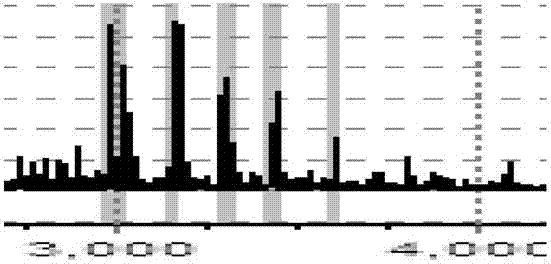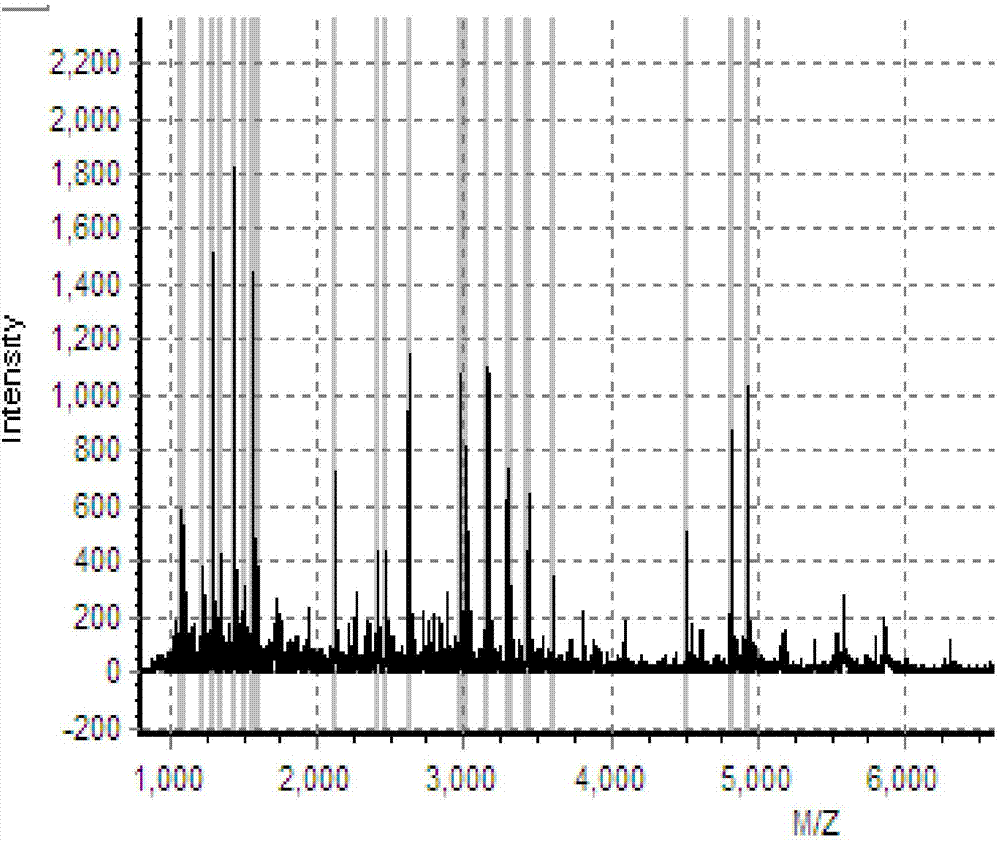Mass spectrum model for detecting decayed tooth protein and construction method
A mass spectrometry model and dental caries technology, applied in the field of dental caries detection, can solve the problems of undisclosed characteristic proteins or markers of oral diseases, and achieve the effect of reasonable and feasible construction method, high sensitivity and specificity, and reasonable and feasible design
- Summary
- Abstract
- Description
- Claims
- Application Information
AI Technical Summary
Problems solved by technology
Method used
Image
Examples
Embodiment 1
[0043] Example 1 Establishment of dental caries susceptibility mass spectrum model
[0044] 1. Samples and instruments:
[0045] The saliva samples were selected from 29 cases, 14 of which were from patients with dental caries, and the other 15 were from healthy people. The patients with dental caries were all confirmed by pathological reports. All saliva samples were taken on an empty stomach before eating in the morning, and the saliva was separated and stored in a -80 low-temperature refrigerator.
[0046] Matrix-assisted laser desorption time-of-flight mass spectrometry CLIN-TOF and the WCX magnetic bead kit used in the experiment were developed by China Bioyong Company. The data analysis software Bioexplorer of Bioyong Company was used to preprocess the data, and the processed data was processed by the genetic algorithm package genalg of the statistical analysis software R2.6.2.
[0047] 2. Technical route:
[0048] Collection of saliva: Collect saliva in BD tubes. Mi...
Embodiment 2
[0068] Example 2 Identification of caries characteristic protein
[0069] Magnetic bead enrichment method
[0070] 1. After the peak to be identified is determined according to the analysis, back check the sample with the highest intensity of the peak to be identified among the pre-processed samples.
[0071] 2. Identify the magnetic beads used in previous experiments. Treat 20 copies of this sample in parallel. Enrichment into one tube.
[0072] 3. Centrifuge at 1300rmp for 5min. Take the supernatant on a magnetic rack. Avoid leaving magnetic beads to affect later experiments.
[0073] 4. Spin the liquid dry and mark.
[0074] Adopt the Nano Aquity UPLC liquid phase system of Waters Company: the parameters are set as follows, trapping column: 5μm, 180μm×20mm, nanoAcquity TM Column; analysis column: 1.7μm, 75μm×150mm, nanoAcquity TMColumn; mobile phase A: 5% acetonitrile, 0.1% formic acid in water; mobile phase B: 95% acetonitrile, 0.1% formic acid in water, all so...
Embodiment 3
[0081] Example 3 Establishment of caries protein detection model and caries susceptibility detection
[0082] A total of 37 saliva standard samples were selected for model training, 9 of which were from dental caries patients and the other 28 were from healthy people.
[0083] In addition, among the 90 samples to be tested clinically, 30 were known to be from patients with dental caries, and the other 60 were from healthy people; the patients with dental caries were all confirmed by pathological reports.
[0084] All the above saliva samples were taken in the morning on an empty stomach without eating, and the saliva was separated and stored in a -80 low-temperature refrigerator.
[0085] The caries characteristic protein peaks screened in Example 1 were used to establish a mass spectrum model of caries proteins. The model is determined to use 3 input variables, namely: 3324.8m / z, 3186.2m / z, 3195.8m / z.
[0086] image 3 In the middle is the sample spectrum of the healthy gr...
PUM
 Login to View More
Login to View More Abstract
Description
Claims
Application Information
 Login to View More
Login to View More - R&D
- Intellectual Property
- Life Sciences
- Materials
- Tech Scout
- Unparalleled Data Quality
- Higher Quality Content
- 60% Fewer Hallucinations
Browse by: Latest US Patents, China's latest patents, Technical Efficacy Thesaurus, Application Domain, Technology Topic, Popular Technical Reports.
© 2025 PatSnap. All rights reserved.Legal|Privacy policy|Modern Slavery Act Transparency Statement|Sitemap|About US| Contact US: help@patsnap.com



